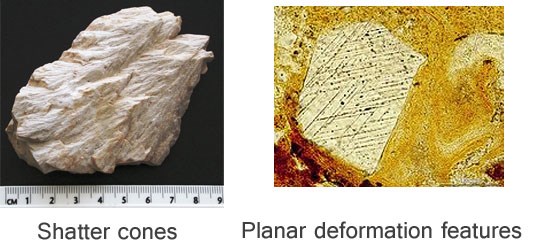Lake Taihu (translates as "Grand Lake") is the third largest freshwater lake in China. The Lake’s circular structure suggests it could have been formed by a meteor impact. Shock metamorphic features found in the nearby bedrock provide the geological evidence for such an impact. Shock metamorphosis is thought to only occur under the tremendous forces generated when a meteor strikes the Earth. These features include: 1) shatter cones, distinctive conical shapes that form beneath meteorite impact craters, 2) planar fractures which are distinctive cracks in quarts grains, and 3) planar deformation features in quartz and feldspar seen under the microscope which consist of thin planes of glassy material arranged in parallel. This impact is thought to be greater than 70 million years old, and possibly from the Late Devonian Period.

Geology of Taihu Region
Fossils indicate that Lake Tai was dry land until the ingression of the East China Sea during the Holocene epoch. It was during this period that its limestone bedrock formed. The growing deltas of the Yangtze and Qiantang rivers eventually sealed off Lake Tai from the sea, and the influx of fresh water from rivers and rains turned Lake Tai into a freshwater lake.
The Lake Taihu area is rich in carbonate limestone rock and has high rainfall. Limestone is a sedimentary rock composed largely of calcite or calcium carbonate. The primary source of the calcite in limestone are the skeletal remains of marine organisms such as coral.
Weathering of limestone involves carbon dioxide and water. Rain, on its way through the atmosphere to earth forms a weak acid. Carbon dioxide in the atmosphere combines with the rainwater to form carbonic acid (H2O + CO2 -> H2CO3). Though weak, when carbonic acid comes into contact with the mineral calcite (CaCO3) which is the main component of limestone, calcium and bicarbonate ions are removed causing the rock to dissolve and erode. The uneven effects of this process create the perforations and strange shapes in Taihu rock. Constant weathering and rainwater erosion over the ages bore holes through the rocks, and form natural pieces of art. On a larger scale, these same processes carve massive cave systems, sink holes, Karsts and other geologic features.
Because of impurities, such as clay, sand, organic remains, iron oxide and other materials, many limestones exhibit different colors, especially on weathered surfaces. The color of Taihu limestone is generally tan, white or light gray, but dark colors can also be found.
Natural or man-made?
Often, Taihu rocks are not works of nature alone, many of these rocks have been enhanced by men. Since the Song Dynasty (960-1279) masons on the shores of Lake Taihu have been engaged in the quarrying of rocks on the mountains. They would drill, chisel, grind and polish these rocks to improve their shapes and enhance their beauty. The rocks were then submerged in the lake, so the forces of nature could wash, sculpt, and restore the natural patterns of wear. To what extent the Taihu rocks are natural or enhanced varies from rock to rock.
Logging Requirements:
Please do not put your answer in the log. Please email me with the answers to the following questions:
1. Is this Taihu rock natural or enhanced? How can you tell?
2. Estimate the height of the Taihu rock.
3. Describe the base. What is it made of? Do you think it was contemporary to the Taihu Rock? Please explain.
4. Optional. Go inside, take a look around. Please avoid any spoilers in your logs.